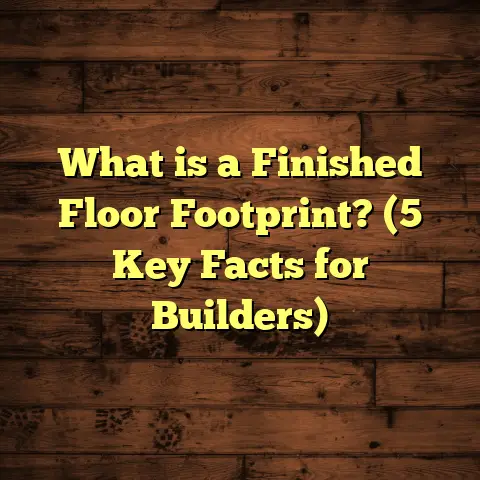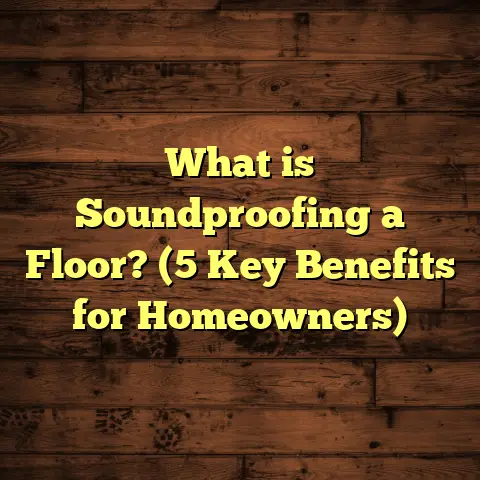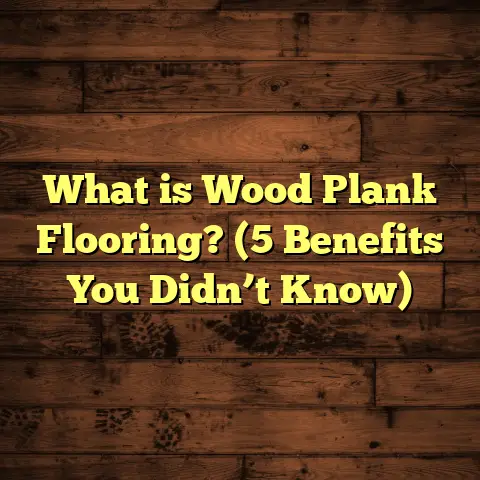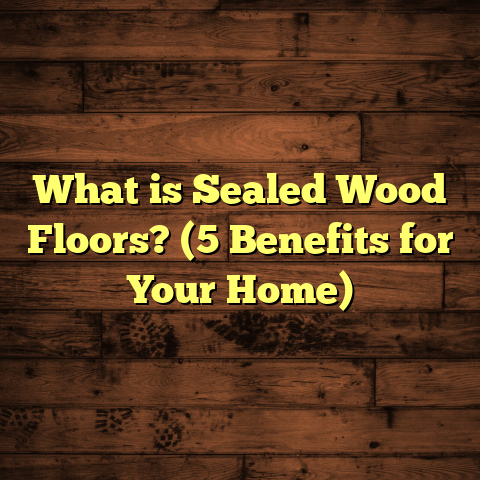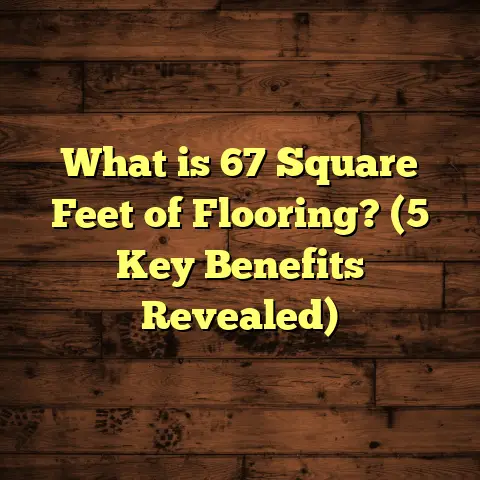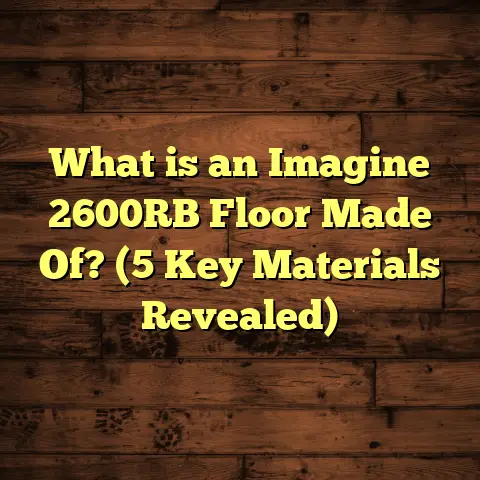What is Revitalizing Hardwood Floors? (5 Tips for a Stunning Upgrade)
Have you ever wished your hardwood floors could look brand new again without having to replace them? Maybe your floors have lost their shine, got scratched up from years of family life, or just feel dull and tired. I’ve been there myself, and I understand how frustrating it can be to see those beautiful wooden surfaces looking worn down. But here’s the great news: you don’t always have to replace your hardwood floors to make them look amazing again.
I want to talk about revitalizing hardwood floors, what that means, why it matters, and how you can give your floors a stunning upgrade that impresses everyone who walks into your home. Whether you’re a DIYer or thinking about calling in a pro, stick with me — I’ll walk you through everything I’ve learned from years of experience.
What is Revitalizing Hardwood Floors?
So, what exactly does revitalizing hardwood floors mean? Simply put, it’s the process of restoring your existing hardwood flooring to look fresh, new, and vibrant again without tearing everything out and installing new planks. It’s about breathing fresh life into the wood by cleaning, repairing damage, smoothing rough spots, and applying a new finish that protects and beautifies.
Think of it like a facial for your wood floors — a combination of cleansing, repairing imperfections, and giving them a protective treatment that makes them glow. This can include:
- A deep clean to remove dirt and grime that has built up over time.
- Repairing scratches, dents, or small cracks.
- Buffing or sanding the surface to smooth out worn or damaged areas.
- Applying a fresh coat of stain or finish to enhance color and protect the wood.
Revitalization saves you money compared to full replacement and helps extend the life of your floors. It also keeps the character of your original wood intact, which is especially important if your home has vintage charm or unique wood patterns.
I like to think of it as a way of honoring the history and beauty of your home’s floors while making them fit perfectly with today’s style.
Why Should You Revitalize Your Hardwood Floors?
You might ask, why bother revitalizing instead of just living with the wear or replacing the floors? Well, from my experience working with homeowners and contractors alike, there are several reasons why revitalization is often the best choice:
1. Cost-Effectiveness
Replacing hardwood flooring can be expensive — on average, between $8 to $15 per square foot for materials and installation. For an average 1,000-square-foot room, that adds up quickly to $8,000 to $15,000 or more.
Revitalizing floors generally costs far less. A professional refinishing job typically runs between $3 and $6 per square foot depending on the condition and region. That’s a huge difference when budgets matter.
2. Time Savings
Installing new hardwood can take weeks — removal of old flooring, subfloor inspection or repair, acclimatization of new wood, installation itself, plus drying times for finishes.
Revitalizing usually takes just a few days — deep cleaning and repairs one day, sanding or buffing another day, then finishing coats over the next couple days.
If you want a quick turnaround without major disruption to your home life, revitalizing is often the way to go.
3. Environmental Benefits
By keeping your existing flooring instead of ripping it out, you reduce waste going to landfills. Hardwood is a natural resource that can last many decades if cared for properly.
Revitalizing supports sustainability by maximizing the use of materials you already have.
4. Preserving Character
Older homes often have hardwood floors with unique patterns, knots, and rich colors that give a one-of-a-kind look. Replacing these with new wood means losing that character.
Revitalization lets you keep those original details intact while making the floor look fresh and updated.
5. Increased Home Value
Well-maintained hardwood flooring adds real value when selling your home. Buyers tend to be put off by heavily scratched or dull floors but are impressed by shiny, smooth hardwood.
According to studies by the National Wood Flooring Association (NWFA), homes with refinished hardwood floors tend to sell faster and at higher prices compared to homes with worn-out floors.
What Causes Hardwood Floors to Lose Their Luster?
Before I share my tips on revitalizing hardwood floors, it helps to understand why floors age poorly in the first place. When you know what causes damage, you can better prevent it or fix it.
Here are common reasons hardwood floors lose their shine:
- Foot traffic: Daily walking causes tiny scratches and wear spots.
- Pets: Pets’ nails scratch surfaces; accidents may cause stains.
- Furniture movement: Dragging furniture leaves gouges or dents.
- Sunlight: UV rays fade wood color over time.
- Moisture: Spills or humidity damage wood finish or cause warping.
- Dust and dirt: Grit acts like sandpaper underfoot.
- Improper cleaning: Harsh chemicals or too much water degrade finishes.
In my years of working on floors, I’ve found that most problems are preventable or fixable once you understand how they happen.
5 Tips for a Stunning Hardwood Floor Upgrade
Let me share five key tips that will help you get the best results when revitalizing hardwood floors. These come from hands-on projects I’ve done and advice I’ve given clients that worked every time.
Tip #1: Start With a Thorough Assessment
You want to know exactly what condition your floor is in before spending time or money.
Ask yourself:
- Are there deep scratches or gouges?
- How worn is the finish?
- Are boards loose or squeaky?
- Any areas with water damage or stains?
Sometimes what looks bad on the surface might only need light buffing or cleaning. Other times you may need spot repairs or partial sanding.
I always recommend walking around your space with good lighting and even using a magnifying glass for close inspection. If you’re unsure, bring in a professional for an assessment—it’s worth it.
One client I worked with thought their floors were beyond repair because of pet damage, but after checking carefully we found only some areas needed minor sanding and repairs — saving them thousands.
Tip #2: Deep Clean Before Anything Else
Cleaning seems obvious but many skip this step or do it poorly.
Use a pH-neutral wood cleaner designed for hardwood floors — avoid vinegar-based or ammonia products that strip finish layers.
A microfiber mop works great for removing dust without scratching. For sticky spots or buildup, gently scrub with a soft cloth and cleaner.
Don’t use wet mops or steam cleaners; excess water can seep into seams and cause damage.
My personal go-to is Bona Hardwood Floor Cleaner — easy to use, safe on finishes, and leaves no residue. After cleaning, let the floor dry completely before moving on.
Tip #3: Repair Scratches and Dents Carefully
Small scratches can be filled with colored wax sticks matched to your wood tone; these are inexpensive and easy fixes.
For deeper scratches or dents:
- Lightly sand the damaged area to smooth edges.
- Use wood filler that matches color.
- After drying, sand again gently for an even surface.
Avoid patching with fillers that don’t match color well—uneven spots stand out easily after finishing.
I once helped a homeowner fix several deep pet scratches by mixing custom stain colors into filler wax — the results blended seamlessly!
Tip #4: Decide Between Buffing vs Sanding
This step depends on how worn your floor is.
Buffing lightly abrades the surface using a floor buffer machine with fine sanding pads. It removes minor scratches and dull finish without exposing raw wood underneath. It’s faster, cheaper, and less dusty than full sanding.
Sanding removes the entire top layer down to bare wood. It fixes deep damage but requires re-staining and refinishing afterward. It can be dusty and takes longer.
If your finish is still mostly intact with minor wear, buffing is often enough for revitalization. If there are deep scratches everywhere or you want an entirely new stain color, sanding is better.
In my experience:
- Buffing every 3-5 years maintains floors well.
- Full sanding every 10-15 years resets floors completely but requires more downtime.
Tip #5: Choose the Right Finish for Longevity
The finish protects your floor from wear and impacts its appearance dramatically.
Popular options include:
- Oil-based polyurethane: Durable with warm amber hues but longer drying times and stronger odors.
- Water-based polyurethane: Dries quickly with low odor; colors are clearer and less yellowing over time.
- Hardwax oils: Penetrate wood and create natural feel but require more frequent maintenance.
- Aluminum oxide finishes: Extremely durable factory-applied finishes found on prefinished wood flooring.
For busy households with kids or pets, I usually recommend high-quality water-based polyurethane for its balance of beauty and durability.
Make sure to apply multiple coats (usually 3) for best protection with proper drying time between coats.
Personal Experience With Finish Choices
A family I worked with had oil-based finish on their floors but wanted something lighter with less yellow tint for their renovated kitchen. We stripped old finish completely then applied water-based polyurethane in clear satin sheen.
Not only did it brighten the entire space visually but cleaning became easier too — no sticky residue buildup like before.
They loved how fast it dried too because they could walk on it sooner during their tight renovation schedule.
How Often Should You Revitalize Hardwood Floors?
Maintaining hardwood floors regularly keeps them looking good longer between major refinishing jobs.
Here’s a rough timeline from my observations:
| Maintenance Task | Frequency |
|---|---|
| Regular sweeping/dust mopping | Daily/weekly |
| Damp mopping (wood-safe cleaner) | Weekly/biweekly |
| Buffing (light abrasion) | Every 3–5 years |
| Full sanding & refinishing | Every 10–15 years |
Of course, this varies based on foot traffic intensity, pets in home, and type of finish used.
Common Mistakes to Avoid When Revitalizing Hardwood Floors
From working on many projects, I can tell you these mistakes happen often but are easy to avoid:
- Skipping thorough cleaning before refinishing.
- Using too much water during cleaning.
- Not matching repair fillers correctly leading to noticeable patches.
- Over-sanding causing uneven floor thickness.
- Applying too few finish coats resulting in poor protection.
- Ignoring manufacturer drying times between finish layers.
- Not sanding edges carefully causing abrupt color differences near walls.
Avoiding these pitfalls will save headaches later on.
Data & Research Supporting Revitalizing Hardwood Floors
Let’s look at some numbers that back up why revitalization is such a smart choice:
- A survey from HomeAdvisor found refinishing hardwood floors costs an average of $1,500 – $3,500 per room depending on size.
- According to NWFA statistics:
- Properly maintained hardwood floors last upwards of 100 years.
- Homes with refinished hardwood floors sell 15% faster compared to those with worn flooring.
- 70% of buyers consider hardwood flooring “very desirable.”
These figures show that investing in revitalization increases not just beauty but also market value.
Case Study: Revitalizing Floors in a Historic Home
Recently I helped restore hardwood floors in a 1920s craftsman-style house. The owners loved the original oak flooring but after decades of neglect it was scratched deeply in places with discoloration from water leaks.
After assessing damage we:
- Deep cleaned thoroughly
- Repaired scratched areas using custom mix fillers
- Sanded entire floor lightly to even out wear
- Applied three coats of water-based polyurethane finish
The results were astounding. The warm amber tones returned fully intact while preserving original character marks unique to this home’s oak planks.
The owners were thrilled not only with how gorgeous their floor looked but how affordable it was compared to full replacement estimates they’d received elsewhere (nearly half price).
A Few Handy Tools & Products I Recommend
If you’re thinking about tackling floor revitalization yourself here are some tools/products I trust:
- Bona Hardwood Floor Cleaner: Gentle but effective daily cleaner.
- Minwax Wood Filler: Easy to color-match scratches/dents.
- Floor Buffer Machine Rental: Available at hardware stores; essential for buffing large areas.
- High-quality water-based polyurethane finish: Look for brands like Varathane or Bona.
- Microfiber mop: Non-abrasive dust mop for regular cleaning.
Having the right tools makes all the difference between smooth success and frustration!
What If Your Floors Are Engineered Hardwood?
Good question! Engineered hardwood has a thinner veneer layer compared to solid planks so sanding options are limited—usually only one time lightly before exposing plywood layers underneath.
Buffing and refinishing still work great here though, so revitalization is very much possible without replacing engineered floors entirely. Just check manufacturer guidelines first!
How Does Climate Affect Your Floor’s Lifespan?
Humidity levels impact wood expansion/contraction cycles which over time can cause gaps or warping if unmanaged.
Using humidifiers in winter and dehumidifiers in summer helps keep wood stable. This reduces how often you need major refinishing.
In coastal humid climates like where I live, homeowners tend to revitalize more often due to moisture-related wear but careful climate control makes a big difference!
Final Thoughts From My Experience
Revitalizing hardwood floors isn’t just about looks—it’s about caring for something that adds warmth and style uniquely suited to your home’s personality. I’ve seen clients go from feeling stuck with tired old floors to being proud every time they walk into their living room because their floors shine again.
If you’ve been putting off fixing up your hardwood floors because you thought it was expensive or messy—think again! With some knowledge, patience, and maybe a little help from pros when needed—you can achieve stunning results that last for years.
Have any questions about your specific flooring situation? Want advice on products or techniques? Just ask—I’m here to help you get those beautiful hardwood floors glowing again like new!
